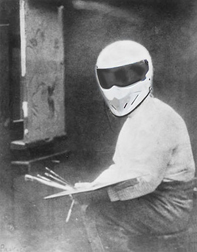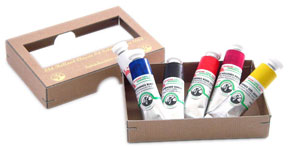view online at https://www.tasart.co.nz/email/mailout.php?content_id=16
Hi , welcome to issue #16 of the Tasart newsletter. Hope you enjoyed the fabulous weather over Easter. We managed to finally move into our new studio at home, unpacked our art books and set up our easels. Hopefully, we'll be able to share some new work in addition to what we've been working on in The Saturday Workshops. We are both itching to produce some new work as well as invite artists to join us in our new space.
Product Review
Le Stig test-drives products & reviews
"A poor craftsman blames his tools."

There is so much misinformation and half-truths out there, it can be pretty confusing for the artist. Since the majority of art supply stores in New Zealand own product agencies (which we do not), we've decided to commission a 'tester' who will test products and give unbiased opinions, and test products against one another. This month, le Stig talks about his favorite high-end oil paint.
If you've ever purchased and painted with some of the most expensive oil paints on the market, you probably already know that you're getting value for money. If not, you're probably wondering why some professional oil paints range from $12 to $60 and others, $20 to $145.
Manufacturers who produce higher end oil paints choose higher priced pigments with a higher ratio of pigments per tube. They use quality binders and the ratio of binder to pigment is less than other artist colours. They also stay away from fillers which are basically used to save money.


Oil paints are different than acrylics in that there isn't a need for a high quantity of extenders and binders. Without a lot of binder, acrylics would just get rubbery in the tube. The same goes for Alkyd-based oils and for this reason, alkyds have a lower price tag even for the cadmium colours.
We asked le Stig to suggest and to talk about his favorite high-end oil paint and this is what he said.
"Women and fine cuisine should be complex. On the other hand, paint should be simple, and a fine quality oil paint should remain as simple as possible without any additions to over complicate the recipes of The Masters. Old Holland is a paint that I use for that reason. I like that Old Holland uses lightfast pigments that are ground with cold pressed linseed oil. And, the fact that the oil is still made in a windmill is tres romantic in an old world way. It doesn't get any more basic than that."
All high quality paints should meet the following criteria. They should have good covering power, good strength of colour, remain completely lightfast (beware of any brand that claims their Alizarin Crimson is lightfast), and have maximum colour intensity. Old Holland guarantees that there are no extenders in their traditional, classic pigments and that all their pigments conform the ASTM ratings of categories I and II.
Below, we created a tint chart using Old Holland and another leading brand of artist oil colour. We laid down a solid mass tone of Cobalt Blue PB28 then, we took 1/4 teaspoon of the same Cobalt Blue and mixed it with an equal portion of white (1/4 tsp). Then we took that mixture, and mixed it with another 1/4 teaspoon of white. As you can see, the Old Holland tint on the right, is much, much stronger than the other leading brand of oil. Proving that Old Holland is giving you more of this high cost pigment in every tube.
Artist Oil Tint Chart Using Cobalt Blue

Most paints manufactured today contain excess oil or gel. Old Holland limits their binders and only use the first pressing of the flax seed which contain maximum acids.

The acids removed from the first pressing of the flax seed work best to oxidize the paint, resulting in a film that is hard and durable. The Old Masters (and Old Holland) use to make their paints, by hand, on stone tables, but today for obvious reasons companies use machine rollers. Old Holland however, still grind their paint using three rollers made of stone. Steel rollers, more commonly used, can alter the colours of the paint, particularly in the earth tones and cadmium colours.

Old Holland paints are so thick, the tubes are manually filled as no machine can handle their density. Each tube comes with a hand painted colour band so that the artist can see the exact colour they're purchasing on each tube.


Old Holland Classic Oils come in 168 Colours with 90 Single Pigment Colours and have been making "the paint of the old masters" since 1664.
Product Spotlight

We are currently offering our 40ml Old Holland Classic Oil Colours at a 25% Savings*
Be the first to own the new Old Holland hand-coloured chart. Just purchase $150 worth of Old Holland Oils and receive this beautiful hand-coloured chart, worth $69.95, for Free.


Now, $79.95, Save $20, on an introductory set of Old Holland.
"Like" our Facebook Page, or share our page with a friend, message us (private or public), with a line that says "I'd like to try Old Holland" and go in the draw to win this set for free. The winner will be drawn on the weekend of May, 12th and announced on the 14th.

Or, treat yourself or someone you love with an Old Holland Gift Set (with free hand-painted colour chart). Save 25% while stocks last.

*offers end the 11th of May, 2012
* * *
Until next time,
Sandy and Jim,
Takapuna Art Supplies
www.tasart.co.nz
Subscription
SUBSCRIBE:
You can subscribe to The Artist's Newsletter at www.tasart.co.nz/email/
UNSUBSCRIBE:
You can unsubscribe by changing your account preferences at www.tasart.co.nz/account/profile or by following this link:
http://www.tasart.co.nz/email/optout.php?rid=&vid=759&eid=
Comments
We'd love to hear from you! If you have any suggestions on how we can improve this newsletter please send comments to info@tasart.co.nz
* * *
This newsletter was written by Sandy Collins on 2012-04-11
…
© Takapuna Art Supplies. All Rights Reserved. www.tasart.co.nz